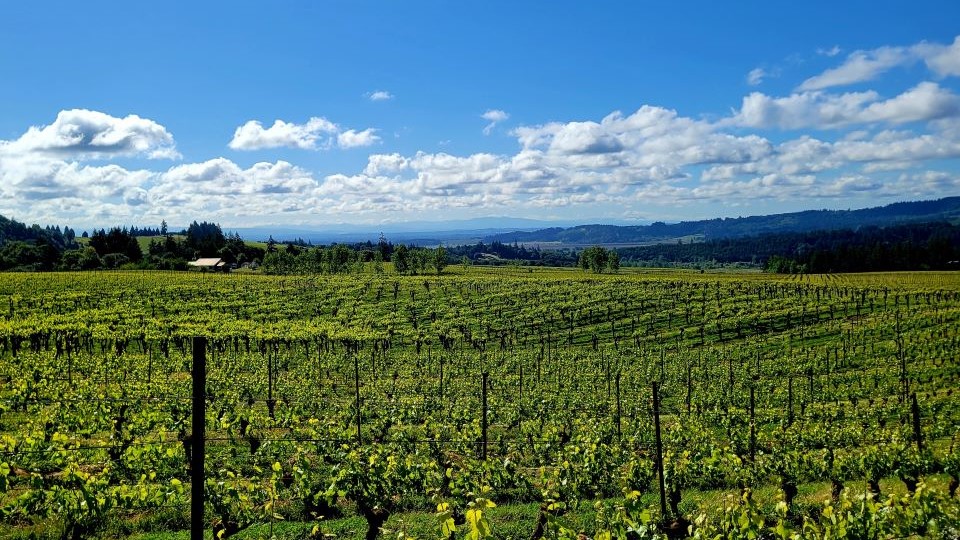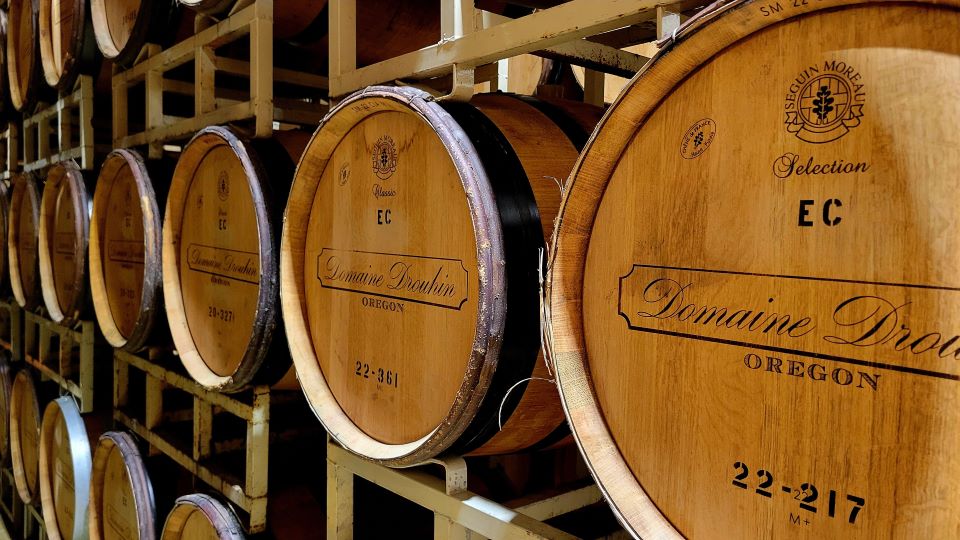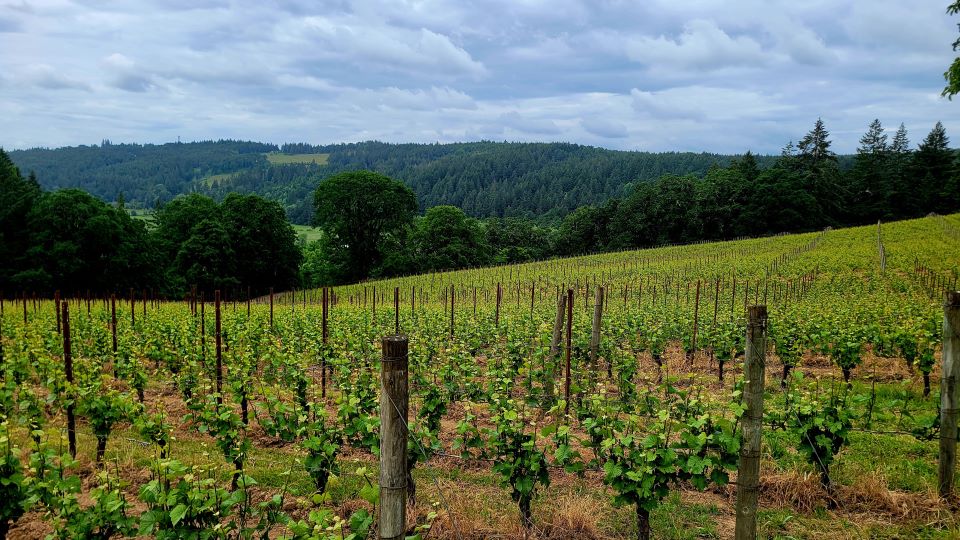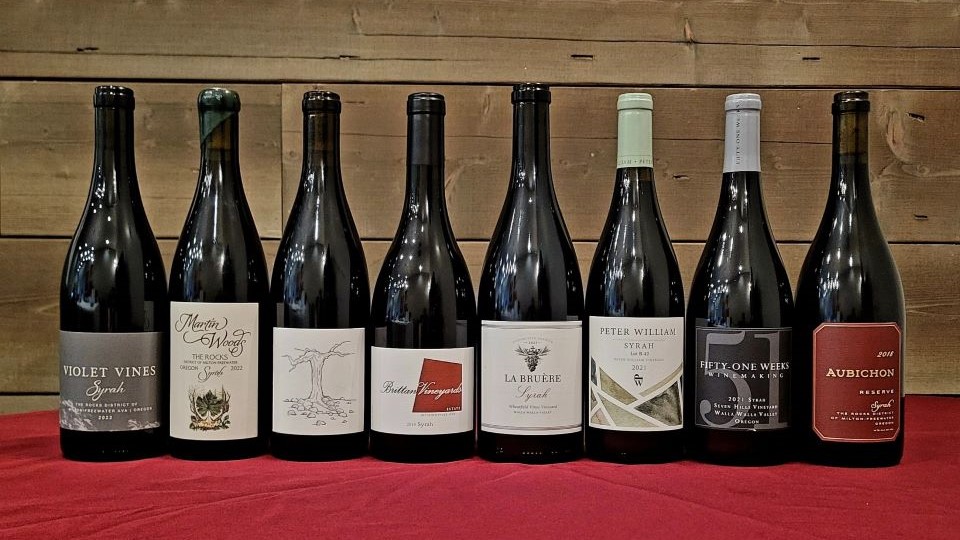Browse using the new Vinous website now. Launch →
Printed by, and for the sole use of . All rights reserved © 2015 Vinous Media
Oregon 2022: The Rollercoaster Vintage
BY ERIC GUIDO | AUGUST 08, 2024
The 2022 vintage in Oregon was a nail-biter and a head-scratcher for winemakers throughout the Willamette Valley. It was a growing season fraught with challenges that tested the skills and decision-making abilities of growers and winemakers in ways never seen before. Being a competent enologist or agronomist wasn’t enough to deal with the curveballs Mother Nature threw at the region. Patience, perseverance, ingenuity, lack of bias and adaptability were all vital to turning out a successful range of wines. In the best-case scenarios, there are many outstanding success stories. However, on the other end of the spectrum, many wines pale in comparison to their usual selves.

The Bethel Heights vineyards in the Eola-Amity Hills.
First, a Little Housekeeping
Before digging in deeper, it’s important to mention that my previous report published in January 2024, Sitting Pretty: Oregon's New Release Pinot Noir, Chardonnay and Beyond, covered over 1,000 wines, focusing primarily on the 2021 vintage, late-release 2019s and a small amount of 2022s. This report falls just short of another 1,000 wines and primarily covers 2022 Pinot Noir and Chardonnay, some 2019s that I didn’t taste six months ago and wines from Rogue Valley and the Rocks District of Milton-Freewater. Combined, these two reports bring our Oregon coverage entirely up to date. Going forward, readers can expect our coverage of Oregon to be more comprehensive than ever, including in-depth reporting on emerging regions. While the Willamette Valley is still Oregon’s premier AVA, areas such as The Rocks District of Milton-Freewater and Rogue Valley continue to deliver elevated quality. As Oregon continues to evolve in an exciting way that goes far beyond Pinot Noir and Chardonnay, it’s clear that the future is very bright for the region and its fans.
The 2022 Growing Season
Outlining the 2022 vintage is a challenge on its own. I spent two weeks in the Willamette Valley tasting with and interviewing over forty winemakers and growers, and even after all of that, new details continue to emerge that further complicate the narrative. Not all individuals are as forthcoming as others, and many want to sugarcoat the situation. I’m sure nearly every reader has heard the phrase, “The best vintage is the one they are trying to sell.” Sadly, this is a reality of the industry worldwide. Oregon is not immune to such antics. My job often traverses from wine-writing to investigative reporting to get the whole story. There are many truths about the 2022 vintage and several misconceptions—digging into the minor details is imperative to understanding what took place and how that ultimately affected the wines.

The barrel aging cellar at Domaine Drouhin.
So, What Are The Truths?
1. The 2022 vintage had a late start to the season and a late finish.
2. An extremely cold and wet spring delayed the start of the season.
3. A decimating frost heavily affected the northern valley.
4. Many growers depended on secondary and tertiary buds due to frost.
5. Frost damaged the vines, creating dead tissue that increased the risk of disease.
6. Flowering took place in late June; some even reported early July.
7. An extremely large fruit set took place for various reasons detailed below.
8. The summer was hot, with several heat spikes.
9. Dry and unseasonably warm conditions prevailed through September and October.
10. Reaching phenolic ripeness was challenging in cooler locations.
11. Achieving balanced ripening between the first, second and third buds proved difficult.
12. The delayed season caused a rush to harvest due to impending rain in late October.
13. The condensed and late season resulted in elevated malic acids in the grapes.
14. The growing season was especially warm, despite many producers saying it was a cool year.
Two thousand twenty-two requires readers to be selective and purchase based on producer. The willingness to sacrifice quantity for quality was paramount in the vineyard and winery. It was, in fact, an abundant year, which may go against conventional logic when also noting that the most defining event of the season was the killing frost that decimated the northern Willamette Valley in late spring. Vines growing under 300 feet in elevation (or even higher if east-facing or contiguous to a valley floor) were at serious risk of losing their first buds. This was the first challenge growers had to overcome. Dundee Hills, Ribbon Ridge and lower elevations in Yamhill-Carlton and Chehalem Mountains were all in jeopardy and, in many cases, lost a large percentage of the early buds to frost.

The Beaux Frères vineyards in Ribbon Ridge.
When frost arrived, most parts of the Eola-Amity Hills, McMinnville and Van Duzer Corridor districts had not seen bud break yet, due to the cold, wet spring. Once the vines experienced bud break and flowering, the area witnessed unusually large fruit sets with huge clusters. In the frost-affected areas, new shoots and secondary buds compounded the situation. Initially, many winemakers reported losing up to 70% of their production due to frost, but many made up their deficit (and then some) after flowering.
Several growers left new shoots and secondary buds on the vines. This new growth can become a perfect environment for mildew, aggravated by an elevated level of disease pressure that persisted the month after the frost. While some winemakers claim that secondary buds can produce quality fruit, others will say the opposite. In the case of Walter Scott—one of the standout portfolios from the 2022 vintage—Ken Pahlow insisted that all of the growers he worked with use only primary buds and crop down to one cluster per shoot. Pahlow explains, “Everyone thought I was crazy, but in the end, we still got 2.6 tons per acre.”
Pahlow’s logic functioned well for Walter Scott. Even with the work he mandated in the fields, vines continued to push their energy into new growth in the form of shoots and clusters. Other successful wines depended on the selection of the bunches in the winery, like at Nicolas-Jay, who reported up to a 70% reduction in quantity for their Chardonnay, or Bergstrom, where Josh Bergstrom decided not to bottle any single-vineyard whites. Vincent Fritzsche of Vincent Wines chose not to bottle his Pinot Noir Armstrong Vineyard from Ribbon Ridge, explaining, “There was simply something wrong with the tannins. Achieving balanced ripeness from cluster to cluster was nearly impossible.” Meanwhile, Fritzsche’s wines from Eola-Amity Hills are a pure joy to taste, showing how much location matters in this vintage.
In the less affected by frost areas, such as Eola-Amity Hills, winemakers suffered through an entirely different set of hurdles. Ben Casteel of Bethel Heights reports, “The frost wasn’t an issue for us because we weren’t budded out yet. It’s so much cooler here. The trade-off is that we were picking so late to achieve ripeness. The Van Duzer Corridor puts us in a good place as vintages get warmer, but when they are cooler, things become more challenging.” Like many winemakers in the colder parts of the Valley, Bethel Heights picked well into October, despite the hot summer and unseasonably warm and dry late-season weather. To make things worse, because of forecasted rain, there was a serious rush for growers to pull fruit in as soon as possible. The rains on October 19th put a hard stop on harvest.
Regardless of whether the challenges were frost or unbalanced ripening, many winemakers reported a large spike in malic acids. This is common with a late and compressed season, and in the case of 2022, it wasn’t unusual for malic levels to range between 4.5-6 grams per liter. To put this into context, tartaric acid explains a wine's mouth-watering qualities and freshness, while malic acid provides more of a tart green apple crunchiness or cheek-puckering sensation. Vincent Fritzsche compares it to ordering a steak black and blue—fully cooked on the outside yet still rare in the middle. Many producers had difficulty understanding the quality of the vintage for the elevated malic acids until the wines underwent malolactic fermentation, making them much softer and palatable. This acidity propelled the 2022s to the next level; it’s one of the saving graces of the vintage.

A lesson in terroir at Walter Scott.
Three Very Different Styles
Chardonnay took the brunt of the damage during the spring frost, which reduced yields and created uneven ripening toward the end. Yet, Pinot Noir didn’t escape unscathed, resulting in varying quality. After tasting deeply through the region, I concluded that there were three very different vintages. Some wines result from heavy extraction, likely from winemakers trying to make up for large yields and inferior fruit, which, with heavy-handed oak treatment, set some wines completely out of balance.
Then, there are partially diluted wines that are almost flat and lack energy. This comes from the rush to pick, uneven ripeness at harvest, and winemakers’ dependence on secondary buds. Dilution also occurred from fruit brought in during or after the rain in October.
Lastly, the successful wines of the vintage are vivid and pure with notable acidity. Sometimes, they are savory in profile but always built on a solid core of fruit. To achieve this healthy harvest, winemakers often had to clear enormous hurdles. For example, Mimi Adams and Maggie Harrison of Antica Terra rented a helicopter to fly in a figure-eight pattern over the vineyards all night, guided only by small bonfires that lined its perimeter, to circulate warm air down into the vineyards.
The quality of the successful wines of the vintage is just behind 2021, the heat dome year where wines are ripe and powerful yet also wonderfully balanced and structured. It’s easy to compare 2022 to a vintage like 2010, which was also a late harvest, yet the 2010s possess more structure and are just now starting to come around. In most cases, the 2022s are already more immediate and pleasing on the palate. However, I expect them to mature well through medium-term cellaring. This vintage defies classification and truly depends on a combination of sacrifice, hard work, patience and a little luck. With all of that said, the update to the vintage chart reflects the region as a whole, not just the producers who culled magic from this difficult year.

Oregon Syrah is is up and coming.
The World Beyond Pinot Noir and Chardonnay
Over the past decades, Oregon solidified its place in the world of wine with Pinot Noir. Granted, Chardonnay was also there at the beginning, but it is only over the last ten years that it has made a significant comeback. However, outside of this dynamic duo, Oregon excels with a mix of varieties worthy of attention. First and foremost: Syrah and Grenache. As detailed in my previous article, the Rocks District of Milton-Freewater lies entirely on the Oregon side of the Walla Walla Valley. Currently, there are far more wineries on the Washington side of the border taking advantage of this fantastic piece of terroir. But with each visit, I find more and more Oregonians trying their hand at Rhône varieties, Cabernet Sauvignon and Cabernet Franc from the Rocks. There are growing pains, as several wines still mask much of that “Rocks District funk” with an aggressive hand in the winery. It will only be so long before winemakers resolve these issues and many more projects centered around this tiny AVA in the extreme northeast of the region emerge. Additionally, Milton-Freewater (the town) is undergoing a redevelopment project that will bring significantly more wine-loving tourists to the area.
In the southwest of Oregon, the Rogue Valley provides a diverse landscape that allows winemakers to experiment with everything from Rhône to Bordeaux, Spanish and even Italian varieties. This location is much warmer than the Willamette Valley, with higher elevations ranging from 1,000 to 2,100 feet. Vineyards span the cooler hillside locations, as the valley floor is too warm for viticulture. Like the Willamette Valley, the Rogue Valley enjoys drastic diurnal shifts that help grapes maintain aromatics and acidity. While quality across the board is still variable, I’ve already found several exciting wineries located in or sourcing from this area, including DANCIN Vineyards, Foris, Peter William Vineyard, Ryan Rose Wine, Cliff Creek and Resistance Wine Company. I have plans to spend some time in the area next year, as I believe this is just the tip of the iceberg.
I tasted the wines for this article in Oregon during in-person visits and group tastings in May 2024.
© 2024, Vinous. No portion of this article may be copied, shared or re-distributed without prior consent from Vinous. Doing so is not only a violation of our copyright, but also threatens the survival of independent wine criticism.
You Might Also Enjoy
Sitting Pretty: Oregon's New Release Pinot Noir, Chardonnay and Beyond, Eric Guido, January 2024
Oregon’s 2019 Pinot Noirs - A Return to Classicism, Josh Raynolds, February 2022
Oregon Outside the Pinot Noir Box, Josh Raynolds, September 2020
Show all the wines (sorted by score)
- 00 Wines
- 99 West
- Abacela Winery
- Abbott Claim
- Adelsheim Vineyard
- Alexana Estate
- Alloro Vineyard
- Amalie Robert Estate
- Amaterra
- Amity Vineyards
- Andante Vineyard
- Angela Vineyards
- Anne Amie Vineyards
- Antica Terra
- Approachment Wine Company
- Argyle
- Arterberry Maresh
- Aubaine
- Bacus Vineyards
- Barking Dog
- Beaux Frères
- Benton-Lane
- Benza Vineyards
- Bergstrom Wines
- Bethel Heights
- Big Table Farm
- Boedecker Cellars
- Brandborg Vineyard and Winery
- Brick House Wine Company
- Brittan Vineyards
- Broadley Vineyards
- Brooks Wine
- Bryn Mawr Vineyards
- Burton Bittman Wines
- Caballus Cellars
- Cana's Feast
- Capital Call Vintners
- Carlton Hill Vineyard
- Chehalem Winery
- Chemistry Wines
- Child's Play
- Christopher Michael Wines
- Circadian Cellars
- Cliff Creek
- Coelho Winery
- Coeur de Terre Vineyard
- Colene Clemens Vineyards
- Composition
- Corollary Wines
- Cristom Vineyards
- DANCIN Vineyards
- David Paige Wines
- Delille Cellars
- Del Rio Vineyard Estate
- Denison Cellars
- Dion Vineyard
- Division Winemaking Company
- Dois Irmaos Winery
- Domaine Divio
- Domaine Drouhin Oregon
- Domaine Loubejac
- Domaine Lumineux
- Domaine Rogue
- Domaine Roy & Fils
- Domaine Serene
- Domaine St. Laurent
- Domaine Verdant
- Dusted Valley
- Eddy Family Wines
- EIEIO & Co.
- Élevée Winegrowers
- Et Fille
- Evening Land
- Evesham Wood
- Fairsing Vineyard
- Fifty-One Weeks Winemaking
- Flâneur Wines
- Foris Vineyards Winery
- Fossil & Fawn
- Fullerton Wines
- Furioso Vineyards
- Gamine
- Gargantua
- GC Wines
- Gemini Vineyards
- Goodfellow Family Cellars
- Gothic
- Grace + Vine
- Gran Moraine
- Granville Wine Co.
- Guillen Family Wines
- Haden Fig
- Hamacher Wines
- Holocene
- Hope Well
- Hundred Suns Wine
- Hyland Estates
- Idiot's Grace
- J.K. Carriere
- Johan Vineyards
- Joleté
- JWrigley Vineyards
- Karta Wines
- Kelley Fox Wines
- King Estate Winery
- Kings Ridge
- Knudsen Vineyards
- Kudos
- La Biblioteca
- Lachini Vineyards
- Landlines Estates
- Lange Estate Winery
- Lavinea
- Le Cadeau
- Lemelson Vineyards
- Lichtenwalter Vineyard
- Lingua Franca
- Longplay Wine
- LucidWild Estate
- Lytle-Barnett
- Maison Jussiaume
- Martin Woods
- Matzinger Davies
- Montinore Estate
- Morgen Long
- Naumes Family Vineyards
- Nicolas-Jay
- Nightshade
- North Valley Vineyards
- Northwest Ridge
- Nysa
- Oak Knoll Winery
- Open Claim
- Paradis Vineyards
- Patricia Green Cellars
- Patton Valley Wines
- Paul O'Brien Winery
- Penner-Ash
- Peter William Vineyard
- Phelps Creek Vineyards
- Pike Road Vineyards
- Ponzi Vineyards
- Potter's Vineyard / Vino Vasai
- PROJECT M Wines
- Raptor Ridge Winery
- Ratio Wines
- Redolent Wine Company
- Resistance Wine Company
- Résonance
- Reustle-Prayer Rock
- Reustle Vineyards
- REX HILL
- Ribbon Ridge Winery
- Rocks of Bawn
- Rodeo Hills
- Rose & Arrow
- Ryan Rose Wine
- Salt Wine Company
- Scenic Valley Farms
- Schmidt Family Vineyards
- Sequitur
- Shiba Wichern Cellars
- Silas Wines
- Sokol Blosser Winery
- Soléna Estate
- Soter Vineyards
- Spire Mountain Cellars
- Stephen Goff Wines
- St. Innocent Winery
- Stoller Family Estate
- SUNU
- Suzor Wines
- Sweet Cheeks Winery
- Tan Fruit
- Tendril Wines
- Terra Vina Wines
- The Eyrie Vineyards
- The Four Graces
- The Pines 1852
- Toil Oregon
- Trathen Hall
- Underwood
- Upper Five Vineyard
- Valley View
- Valley View/Domaine Rogue
- Van Duzer Vineyards
- Vincent Wine Company
- Violet Vines
- Violin
- Walnut Ridge Vineyard
- Walter Scott
- Westmount
- White Rose Estate
- Wild Hills
- WillaKenzie Estate
- Willamette Valley Vineyards
- Willful Wine
- Winderlea Vineyard and Winery
- Windhorse by Capital Call Vintners
- Witness
- X Novo
- Yamhill Valley Vineyards
- Youngberg Hill
- Zena Crown Vineyard
